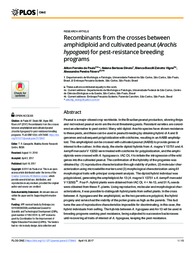Recombinants from the crosses between amphidiploid and cultivated peanut (Arachis hypogaea) for pest-resistance breeding programs.
Recombinants from the crosses between amphidiploid and cultivated peanut (Arachis hypogaea) for pest-resistance breeding programs.
Author(s): PAULA, A. F. de; DINATO, N. B.; VIGNA, B. B. Z.; FAVERO, A. P.
Summary: Peanut is a major oilseed crop worldwide. In the Brazilian peanut production, silvering thrips and red necked peanut worm are the most threatening pests. Resistant varieties are considered an alternative to pest control. Many wild diploid Arachis species have shown resistance to these pests, and these can be used in peanut breeding by obtaining hybrid of A and B genomes and subsequent polyploidization with colchicine, resulting in an AABB amphidiploid. This amphidiploid can be crossed with cultivated peanut (AABB) to provide genes of interest to the cultivar. In this study, the sterile diploid hybrids from A. magna V 13751 and A. kempff-mercadoi V 13250 were treated with colchicine for polyploidization, and the amphidiploids were crossed with A. hypogaea cv. IAC OL 4 to initiate the introgression of the wild genes into the cultivated peanut. The confirmation of the hybridity of the progenies was obtained by: (1) reproductive characterization through viability of pollen, (2) molecular characterization using microsatellite markers and (3) morphological characterization using 61 morphological traits with principal component analysis. The diploid hybrid individual was polyploidized, generating the amphidiploid An 13 (A. magna V 13751 x A. kempff-mercadoi V 13250)4x. Four F1 hybrid plants were obtained from IAC OL 4 × An 13, and 51 F2 seeds were obtained from these F1 plants. Using reproductive, molecular and morphological characterizations, it was possible to distinguish hybrid plants from selfed plants. In the cross between A. hypogaea and the amphidiploid, as the two parents are polyploid, the hybrid progeny and selves had the viability of the pollen grains as high as the parents. This fact turns the use of reproductive characteristics impossible for discriminating, in this case, the hybrid individuals from selfing. The hybrids between A. hypogaea and An 13 will be used in breeding programs seeking pest resistance, being subjected to successive backcrosses until recovering all traits of interest of A. hypogaea, keeping the pest resistance.
Publication year: 2017
Types of publication: Journal article
Keywords: Amphidiploid, Peanut, Pest
Observation
Some of Embrapa's publications are published as ePub files. To read them, use or download one of the following free software options to your computer or mobile device. Android: Google Play Books; IOS: iBooks; Windows and Linux: Calibre.
Access other publications
Access the Agricultural Research Database (BDPA) to consult Embrapa's full library collection and records.
Visit Embrapa Bookstore to purchase books and other publications sold by Embrapa.

